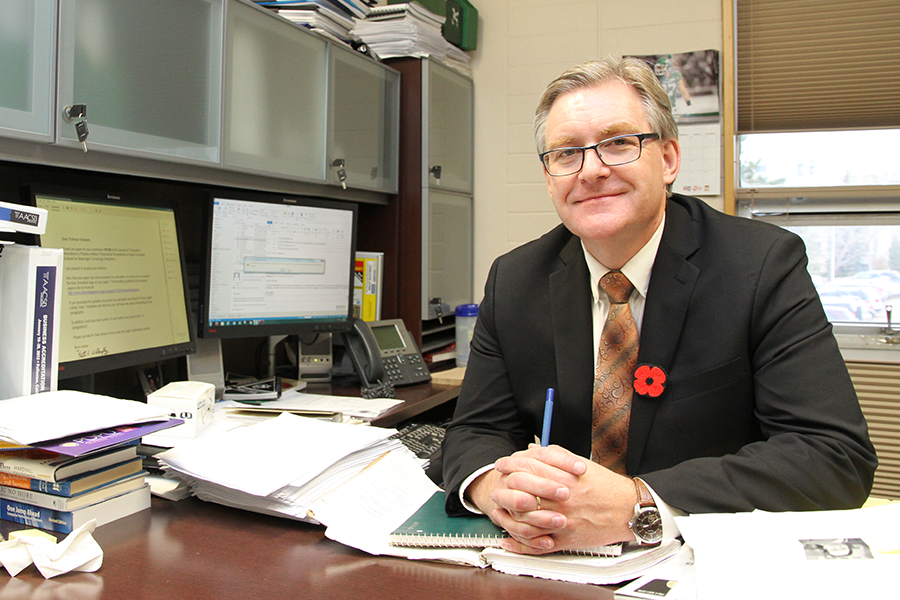Reviewing Keith Willoughby's CV, one cannot help but notice the variety in his research topics, ranging from sports and health care to public transit and game shows.
An associate professor in the Edwards School of Business, his work focuses on production, statistics and operations management, which is "the use of analytical procedures and quantitative methods to try to explore real business problems and find better solutions," and can ultimately be applied to myriad number of scenarios and subjects.
Case in point: before returning to the U of S in 2005 (where he previously held a faculty role from 1997-99), he spent six years at Bucknell University in Pennsylvania, where he taught a course in computer simulation. While not the sexiest of topics, Willoughby found a way to engage his students in the subject matter with everyone's favourite game show.
"We looked at computer simulation models for spinning the big wheel on The Price is Right," he said. "In essence, if you are the first person spinning the wheel, when should you stop? If you get 50 cents, should you spin again? If you get 90 cents, should you stop? In other words, what's the stopping rule?"
Using a bit of math, the class developed a thorough spreadsheet simulation model that calculated the odds of hitting the jackpot during the Showcase Showdown segment. "They determined that if you're the first person to spin, you should stop at 70 cents and above," he said. "If you're the second person, you should stop at 55 cents and above."
While not the most traditional way of teaching numerical simulation, Willoughby noted that it is much more interesting for students. "If you do a computer model of producing widgets, nobody knows what a widget is. People are going to fall asleep," he said.
Additionally, it gives students a real-world approach to operations and statistics. "At the end of the day, it was tied to a problem that students could see because a lot of them had seen The Price is Right," he said. "It allowed them to capture a problem and put it in a context they could understand."
Willoughby used similar methods in past research within the health-care sector. He spent three years with the Health Quality Council, focusing on operational models to improve efficiencies such as emergency room wait times, treatment access and error reduction.
"I'm a real applied person," he said. "I like looking at how I can apply these tools in real problems, especially ones that make sense to students. If you can give them a context in which these tools can be applied, they begin to see how to apply it in real life, and it makes sense."
An associate professor in the Edwards School of Business, his work focuses on production, statistics and operations management, which is "the use of analytical procedures and quantitative methods to try to explore real business problems and find better solutions," and can ultimately be applied to myriad number of scenarios and subjects.
Case in point: before returning to the U of S in 2005 (where he previously held a faculty role from 1997-99), he spent six years at Bucknell University in Pennsylvania, where he taught a course in computer simulation. While not the sexiest of topics, Willoughby found a way to engage his students in the subject matter with everyone's favourite game show.
"We looked at computer simulation models for spinning the big wheel on The Price is Right," he said. "In essence, if you are the first person spinning the wheel, when should you stop? If you get 50 cents, should you spin again? If you get 90 cents, should you stop? In other words, what's the stopping rule?"
Using a bit of math, the class developed a thorough spreadsheet simulation model that calculated the odds of hitting the jackpot during the Showcase Showdown segment. "They determined that if you're the first person to spin, you should stop at 70 cents and above," he said. "If you're the second person, you should stop at 55 cents and above."
While not the most traditional way of teaching numerical simulation, Willoughby noted that it is much more interesting for students. "If you do a computer model of producing widgets, nobody knows what a widget is. People are going to fall asleep," he said.
Additionally, it gives students a real-world approach to operations and statistics. "At the end of the day, it was tied to a problem that students could see because a lot of them had seen The Price is Right," he said. "It allowed them to capture a problem and put it in a context they could understand."
Willoughby used similar methods in past research within the health-care sector. He spent three years with the Health Quality Council, focusing on operational models to improve efficiencies such as emergency room wait times, treatment access and error reduction.
"I'm a real applied person," he said. "I like looking at how I can apply these tools in real problems, especially ones that make sense to students. If you can give them a context in which these tools can be applied, they begin to see how to apply it in real life, and it makes sense."
